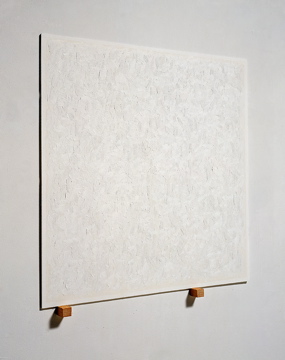
Robert Ryman, "Initial," 1989. Oil on gator board with wood, 23 3/4 x 23 inches. Private Collection, New York. Courtesy PaceWildenstein, New York.
On Monday I had the pleasure of attending the last edition of this season’s Art21’s Salon Series with Robert Ryman and Urs Raussmüller. Going into the evening, I kept thinking about the strange directions a conversation can take discussing a body of work that contains a healthy dose of white paintings. But through the conversation, Ryman and Raussmüller convinced the crowd in attendance, including myself, that they aren’t white paintings, they’re actually light paintings, and you can forget any Thomas Kinkade associations and/or wisecracks (but in case you really care, his latest work is called, Pinocchio Wishes Upon a Star. Oh yes!).
Ryman’s works are often about paint working with light on a surface and over time. It was an odd pleasure to hear two people talk about the simple joy of noticing and experiencing light through the physical product of Ryman’s efforts. In the art classroom, light is often a thing to be corrected, adjusted, fixed, sharpened, brightened or toned-down. Not nearly as often is it discussed as the subject itself. I began to wonder what paintings about light might look like in my own classroom. After recently teaching a unit where students created paintings about power, I reflected on the fact that I was, frankly, unprepared for some of the definitions of power depicted by my students. But paintings about light? Besides literal representations of bulbs and sunrises, abstract color experiments, and perhaps one or two obsessed with Kinkade, what could I expect? It’s a challenge to get some students to notice if a light is even on, much less admire the qualities of it.
But Ryman’s work, whether students love it or hate it (not to mention colleagues, spouses, friends), get the viewer to slow down. Questions will arise about the kind of white, or whether it’s a flat white. Some will ask whether the work is symbolic or if it is simply about the paint itself and what it does to or with the eye. Many will question how anyone can find white (or light) so fascinating in the first place. And just as Ryman considers the primary qualities of the paint and light, so should we consider posing these questions and offering these challenges to students.
So… what can paintings about light look like?